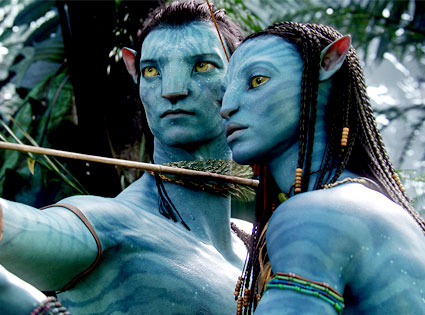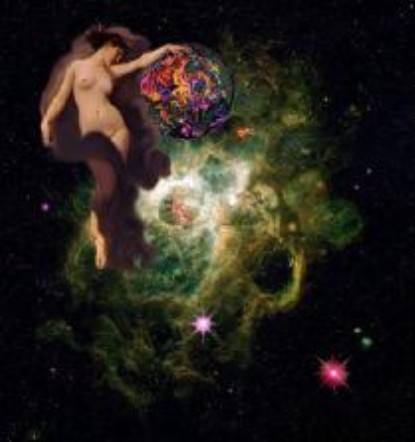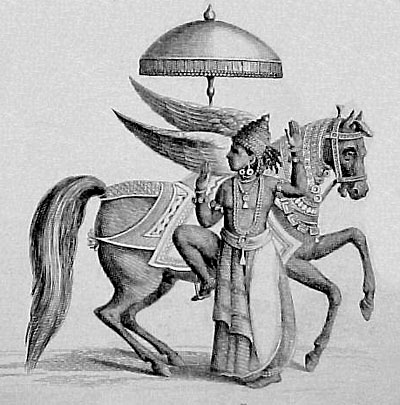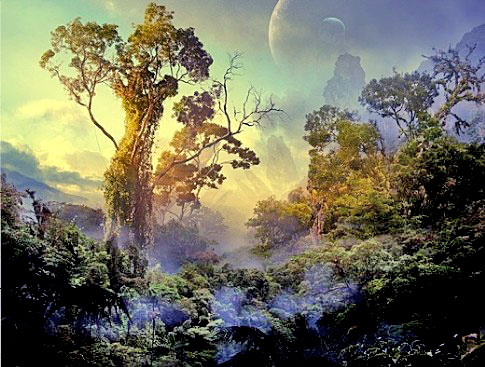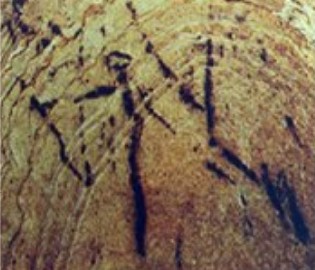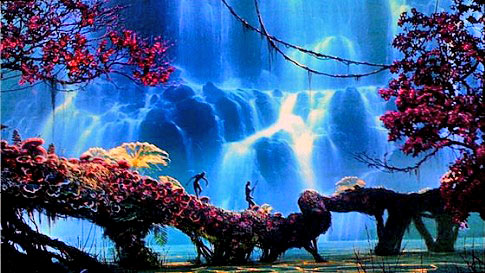|
|
|
by John Lamb Lash 31 December 2009 Flanders - 3 February 2010, Andalucía from MetaHistory Website
As author of a site dedicated to teaching the story of the earth from the earth's point of view, I am pleased to declare Avatar the first masterpiece of a new genre, Gaian science fiction, gi fi.
For once Hollywood has delivered an epic film that reflects the wonder and magic of our world, rather than the lure of other worlds in faraway universes.
Pandora, the exotic planet where the story unfolds, may be considered a parallel world to ours.
Ecologically, it is a realm of spectacular biodiversity and natural invention bordering on magic, like ours. Metaphorically, it is the earth viewed as the scene of a battle between indigenous people and corporate-military predators. Mythically and esthetically light-years beyond Close Encounters of the Fourth Kind, Star Wars and the Matrix Trilogy, here at last is a film that offers a ecoparable for the 21th Century.
Here is the overture to mainstream recognition of the Wisdom Goddess and her story, the Sophianic vision of the Mysteries.
Avatar portrays an alien world, Pandora, but this alien world clearly suggests the earth in the original splendor of Edenic beauty. The plot tells a story of indigenous people who triumph over violence and greed that threaten to turn their native paradise into a wasteland.
Sound familiar?
Avatar is planetary folk lore modeled on the Hero's Adventure made famous by mythologist Joseph Campbell (The Hero With a Thousand Faces) and Jean Houston (The Goddess and the Hero).
In my own contribution to the genre, The Hero - Manhood and Power, I argue that what makes a man a hero is mastery of superfluity, excess power. He needs this excess because he battles against overwhelming forces. In the heroic struggle, the odds are never even. A hero like David always stands against a monstrous superpower like Goliath. What makes man, the male, a hero is the use of his excess power to defeat even more excessive forces.
Every single film and
book based on the hero theme exhibits this motif.
In the film, Sully
receives support and assistance from three sources: the heroine
Neytiri, the Na'vi, the indigenous tribe to which she belongs, and
the Mother Spirit of Pandora, Eywa. Jake Sully is not the sole hero
of the planet he defends against the military-corporate predators,
so the plot of Avatar transcends the traditional limits of this
mytheme.
Finally, at the decisive
moment then the natives battle with bows and arrows against
state-of-the-art military hardware and incendiary bombs, Eywa
intervenes: she sends the unleashed fury of the forest animals
against those who would desecrate her planetary body for power and
profit.
Cameron presents in Pandora a cinematic metaphor for Mother Eartyh, as some earthlings quaintly used to call her.
Animism, the oldest collective mind-set known to our species, asserts that this planet which gives all that is required for life is not a dumb unconscious material globe. It is an intelligent. self-regulating creature interactive (animistically bonded, if you will) with the creatures in its atmosphere, both human and non-human.
Likewise, modern Gaia theory affirms that the biosphere of the earth regulates itself in a constant feedback loop with the biota, the totality of sentient life.
Even though it uses computer generated imagery (CGI) to depict Pandora, the astonishing beauty of animation in this film suggests how the world can look in the Edenic gaze of imagination.
Technology
cannot produce this gaze, or substitute for it, but handled with
consummate artistic skill, as Cameron has done, it may just usher
the mind to the threshold of its own visionary potential.
But to enact the story
via a conscious bond with the living presence of the planetary
spirit, is something else again. The computer-generated imagery of
Avatar displays a world of immense beauty and wonderment, as this
world of ours would look in the thrill of that enactment.
"Gaia in Chaos,"
original painting by Ed Fisher
Nature Worship
An outcry against Paganism, Gaia religion, Wicca, and nature worship can be heard across the globe. The main objection of the Christophiles is that we cannot find salvation in the natural world, but only through the supernatural messiah. I would reply, if we really live in harmony with the natural world, we don't need salvation in the first place.
This response informs
the argument in my book,
Not in His Image
(Chelsea Green,
2007) where I trace the roots of global terrorism to the "salvationist
virus" of
Judeo-Christian-Islamic faith in a
divine redeemer.
Heresy comes from
a Greek root meaning simply "to choose, to have a choice."
In Not in His Image, I compare this massacre to the wholesale genocide and "conversion" of the Native Americans by European colonists.
Avatar makes no attempt
to depict conversion of the natives to a religious ideology of
divine paternalism, perhaps just to bribe them with t-shirts and
six-packs. The invaders of Pandora declare no triumphant religious
ideology: they are pure military-corporate predators in search of a
rare mineral. But an honest study of modern history shows that
corporations and military orders from the US Army to the
Knights of Malta rely on divine
paternalism, putting God on their side.
Old-time christians are particularly upset by the perceived idealization of native peoples, savages with bows and arrows who practice shamanic rites and bond with animals, even when they slay them.
Negative reviews and
outright attacks on Avatar give true believers in God and
Christ an opportunity to vent their spleen and reveal, once again,
how hateful they actually are, how intolerant of co-existence, how
incapable of reverence toward the earth or respect for anyone who
loves and adores it like a great mother animal.
What are they so afraid of? What are they actually protesting?
In large measure, this response is purely ignorant: I defy anyone who would categorically condemn nature worship to define Pagan, or animism, or shamanism. Such ignorance is dangerous, especially when it goes unchallenged and misleads astray people who would otherwise be receptive to the alternative view of nature worship, (goddess religion, as it may also be called), contrasted to worship of an off-planet father god who saves the human race by inflicting doomsday upon it.
At best, the controversy
over Avatar may inspire some people to investigate the correct
meaning of Paganism, nature worship, Wicca, witchcraft, and
shamanism, as such terms are understood by those who embrace the
views and practices comprised.
Considered as a religion or worldview, Paganism is the non-institutional, tribal or community orientation of human culture to the non-humam world, with the intent to preserve a pact or bond with the greater forces of the environment so that human society can survive in a sane and harmonious manner.
As such, Paganism is just the collective cultural expression of the oldest worldview on earth, animism.
An animist is a life scientist empathically involved in the open-ended, open source experiment of human activity on earth.
To an animist, the source of life is also the source of morality, healing, and deliverance from the limits of the human condition, i.e, the source of transcendence. If the source of transcendence is present here and now in the realm of the senses, one does not look elsewhere for it. Jesuit advisors at the Vatican surely know this, having done their homework in anthropology.
This is why they are so terrified of the attraction of the Pandoran world: blissful immersion in the beauteous intelligent design of nature is the blessing of animism, as well as the assurance of reaching the transcendent through the sense world. This assurance is usually dressed up in a philosophical term, divine immanence.
The presence of the Divine in the here and now is the considered view, not blind belief, of Wiccans, Pagans, and indigenous peoples of all cultures in all times.
As long as a
community or an entire civilization (such as the pre-christian
civilizations of Europe and the Mediterranean basin) has such an
assurance, you can't sell the members a ticket to salvation. One way
or another, Avatar touches and awakens that assurance. The sheer
beauty of the film cues the viewer to divine immanence.
Now that is a heady recipe for some wicked fun, perhaps, but hardly equal to the record of the Church of the One True Faith.
The Vatican monopoly on sadism, enforced through the victim-perpetrator bond, is, of course, indirectly threatened by the above sequence of ludicrous associations.
But it gets worse for catholics and old-time christians of all kinds:
They might find some angry Pagans coming after them with native magic.
They might find some Gaian
sorcery and upscaled witchcraft intruding upon their faith-bound
fortress. It must be said - indeed, it is uniquely my pleasure and my
privilege to say it - that revenge, not forgiveness, is essential to
the honor code to Pagan ethics.
Under certain conditions, anyway.
Or that it might promote the cyber-chic
notion of superhumanism, namely, human genetics and mental capacity
modified by computer science or genetic-prosthetic enhancement of
the human body with artificial components as depicted in films such
as RoboCop, the Terminator series (also directed by Cameron), and
AI, the sentimental tale of a android programmed to love.... As if
anyone could program love.
This objection comes from my studies of the Gnostic teachings that
warn about
HAL, simulation, artificial intelligence. AKA
the Archon
factor so clearly described in Gnostic Coptic texts.
His brother's DNA was combined with Na'vi DNA to produce the ten-foot-tall, blue-skinned, cat-like humanoid that can live among the Na'vi and breath the atmosphere of Pandora, as ordinary humans cannot. When his brother died, Jake, who lost the use of his legs in Marine action, gets to replace him.
His innocence combined
with brute warrior strength and foxhole savvy actually make him a
superb agent to infiltrate the Na'vi and learn their ways to the
advantage of the predators - such is his assignment, at least.
Somewhere on this site, I noted that bilocation is the biggest thrill in the world.
Coded in the mythological image of twins is the experience of bilocation: being physically in two places at once and being aware of both places, that is, acting in the one place while fully present and acting in the other.
Bilocation is a yogic feat and a power of accomplished shamans, a
feat for which there is some first-hand testimony. I've bilocated on
numerous occasions. You don't have to believe me, but I have
experienced it first-hand.
Astral projection is a mild form, virtual bilocation, the extreme form.
The NDE or near death experience attests to a type of bilocation in which people see their bodies prone on a hospital bed, presumably dead, but they do not necessarily see the other body that observes the dying person. In some NDEs, however, people wander off in their double and then return to life.
Participants in the Eleusinian Mysteries attested to the experience of wandering in a second body in the Elysian Fields, comparing initiation to death - but, happily, a death that you can survive.
Suggested image of bilocation as occurs in astral projection,
Bilocation is a form of twinning.
Jake Sully is a twin twice over. He had a twin brother, and he has an avataric twin, his own hybrid. Sully has to enter a kind of isolation tank and go to sleep for his conscioiusness to be teleported to Pandora where his hybrid is awake and active. He must enter a kind of shamanic trance in order to live and act in his avataric identity on Pandora.
Whether Cameron knew it
or not, this feature of the plot is not his invention: worldwide
lore of shamanism attests to the capacity of the shaman to fall into
a trance, drop to the ground in a stupor. This is called ecstatic
transport. Then in his dreaming body or plasmic double, the shaman
explores other worlds or may appear like a normal person in this
world, but physically removed from where his body rests in trance.
The Matrix is a simulated world, an virtual reality zone sustained by computer programs that project huge fields of simulated (read: faked) colors, tastes, sounds, etc. It is not the real sensory world of planet earth but the earth conceived as a "prison planet," a term used by YouTube alarmist Alex Jones of infowars.com.
Jones appears to be a Christian who scorns "the Gaia one world religion" and condemns Avatar as NWO propaganda that makes us all avatars in the scheme of the Illuminati!
He, the alarmist, would perhaps be alarmed to learn that the concept of prison planet originated with Pagan seers of the Mysteries who compared the solar system to a prison run by the Archons, alien cyborgs.
That
mythological metaphor describes the enslavement of humanity to its
own mental projections and concepts, that is, enslavement to an
alien mentality operating within our own minds that cannot be blamed
on external sources, although it can be spun and affected by
external influences.
Like shamans through the ages, Sully goes into a trance so that he can act in his double, his twin self. The trick is, the twin self in this case has been constructed artificially - yet it is authentically the same vehicle a shaman would use to explore the supernatural dimension of this world or venture to other worlds. Those who have done it (including myself) can attest that bilocation is real, not a fantasy.
As real as living and moving in this
ordinary world.
The Matrix trilogy is a pretty good metaphor for the prison planet of Gnostic seers, but it can't stand a candle to the mythological and shamanic twinning in Avatar.
Typical image of the tenth avatar of Vishnu, Kalki, the Horse
Avatar.
In its oldest sense, the word avatar derives from a Sanskrit verb meaning "to descend."
In Hindu myth, an avatar is a divine being who descends into human form to intervene in history. Not a Christ-like messiah who dies to save the world or implements divine judgment, but an agent of rescue like a lifeguard on a beach. (The form of the avatar in Hindu religion is phantasmal, or docetic in Gnostic language: an apparition. But then the entire world is an apparition in the Hindu view!)
There are ten avatars of Vishnu, the sleeping god of Hindu religion.
As Vishnu dreams the world over immense periods of time, the deity periodically enters the situations he is dreaming, taking on a human body and personality, or animal forms such as tortoise or lion. The ninth avatar of Vishnu was said to have been in human guise: Lord Krishna, an Indian philosopher king who died in 3102 BCE.
The tenth or coming avatar of Vishnu is called
Kalki, pictured as a white horse, sometimes with an archer-warrior
on its back. (I believe this avataric expression may be manifesting
in the
White Lions of Timbavati.)
Here again, Cameron makes impeccable use of mythological and shamanic precedents. Jake Sully is a hero in the service of the planetary earth mother, Eywa - Gaia by another name. He is not a white male messiah figure as some hostile reviews have claimed.
In Not in His Image I show that the profile of the messiah in salvationist faith is clear and unmistakable, consisting of these elements:
Considered
on the last point especially, Avatar's hero is no messiah:
The salvationist messiah is never one of the
people, never an equal member of the human tribe.
Each Pandoran warrior has an akran, a supernatural double or nahual.
This theme is purely shamanic, and timeless in the spiritual and magical legacy of our species. In the scope of animism, human individuals have particular affinities with certain animals. They may call up these animals, encounter them in nature, or shapeshift into them. Over time, animistic cultures often developed into warrior societies, which have to be rigorously distinguished from urban paternal societies.
In warrior societies the figure of the Goddess is central and animal powers are revered as her attributes and projections. The culture of the Na'vi is just such a warrior-hunter society with reverence for the animal powers, as Jake learns when Neytiri teaches him how to kill with reverence and be grateful to the prey. The lesson of the prey-predator bond figures significantly in the final scenes of the film.
The invocation of the animal powers also plays a decisive role
in the outcome of the story.
Like a terma, a wisdom-treasure, it was given to him intact and whole from the first moment. Such an experience is typical of tertons, treasure-finders, as well as of master musicians such as Mozart and Scriabin, who claimed to have heard their huge compositions in a single second.
The French author Balzac, also, claimed to have had a moment of
"cosmic consciousness" in which he saw the entire plot and all the
characters, about 242, of his serial novel, The Human Comedy.
Although he would not allow it to be known in his lifetime, Sir Francis Crick, co-discoverer of the structure of DNA with James Watson, had the vision of the double helix in an altered state induced by LSD.
Scientists who accompanied
Jeremy Narby to Peru for trance rituals with ayahuasca stated that
they were able to see the molecular level of nature directly and
understand and advance their scientific thinking due to the boost of
the sacred medicine plant.
Anyone who has seen the awesome splendor of Gaia, vivid, pulsating, miraculously designed, alive in every detail and lusciously inviting in the panorama of sensations that surge blissfully into the body like the rush of the ocean through the pores of a coral reef - anyone who has had that experience at first-hand will, I believe, attest to those who have not had it that the sheer esthetic splendor of this film points to the blessed vision of Elysium, Terrestrial Paradise. Not an alien world vision, but the ultimate this-world vision.
Yes, that is really how it looks here in the natural world. Yes, really.
Oh yes it does.
Amazon-like habitat of Pandora with immense trees.
The fact that Cameron and company deliver this vision of nature using the most sophisticated tools of artificiality and simulation, CGI, computer generated imagery, is a breakthrough of its kind.
I do not mean a technological breakthrough, but a breakthrough of perception. In Castaneda's fables of sorcery, Don Juan defines the practice of the mystic warrior as breaking through the fixed parameters of perception.
Cameron certainly achieves this with the special effects of this film. I would say that only an artist who already has a genuine vision to deliver can use CGI in this spectacular manner. CGI itself cannot deliver such a vision.
Even
though it uses the device of simulation to depict Pandora, the
astonishing beauty of animation in this film shows how the planet we
inhabit does truly look in the Edenic gaze of our once and future
innocence.
But Neytiri tenderly advises him:
Neolithic Artemis of Pileta (Andalucía, Spain)
Pagans observe and revere the balance of life.
Comprised in that balance is the precarious equipoise of the ordinary and the sublime. Experimental mysticism consistent with shamanic traditions of untold antiquity reveals that supernatural power is present in the natural world, right here, right now. Gaia's sublimity of beauty is itself a supernatural force.
To enter that beauty and to be rapturously consumed in it, trembling in your cells, and staggering from its impact like a drunken sailor on deck in a typhoon - this entrance, corporeal and immediate, makes the beholder belong to the beauty and long to be forever in that beauty, or else live a life diminished, self-suppressed, narrow and shallow.
After a genuine biomystical
encounter with the Earth Mother in her naked splendor, you no longer
belong just to yourself. And in that encounter, beauty begins to
make you her own.
They claim that nature and natural impulses are sinful and deserve to be punished. They insist on the authority of a supernatural source beyond the earth and humankind. They deal out punishment and reward in complete disregard for merit.
To enforce their twisted, paranoid, pseudo-magical beliefs they
expend enormous effort on killing the real magic wherever it arises
on this planet: in the land and trees, the water and the sky, in
plants, in animals, in children, and in people of true innocence and
high imagination.
At this late date in the cycle of the ages, one may well wonder,
I don't know where Cameron got his mythology, or if he needed or heeded advice from anyone like the likes of me.
In
Living Myth I
register my view that renowned comparative mythologist Joseph
Campbell badly advised Spielberg and Lukas on the plot for Star
Wars. He gave them the dead-end drama of Persian dualism, the battle
of Light and Darkness. What he ought to have given them, I believe,
was a Gaian myth such as the Sophianic vision of the Mysteries.
Cameron's film resonates in many ways to that vision, but its
principal strength is pure shamanic hunter mythology of prehistory.
Here is the perfect image of Artemis, the chaste and elusive huntress of Greek myth. She is best known for having an old man named Actaeon devoured by his hunting dogs when he happened to see her bathing naked in the moonlit, and lusted after her lovely form.
But a more ancient myth reveals the true scope and purpose of the
huntress's vengeful nature: when the hunter Orion exceeded the quota
of animal prey set for him by the Earth Mother, Artemis sent a giant
scorpion to sting him to death. (That version of "the revenge of
Gaia" was not written by James Lovelock.)
She is no figure of the ancient past, however. Portrayed imaginatively in a film, she may now come to walk the world in the flesh. Hollywood is often a predictive oracle of the collective unconsciousness. Neytiri embodies the killing magic able to restore moral balance in the world, comparable to the lethal hunting and horse-riding skill of a Neolithic nymph.
Avatar carries this extremely un-Christian message to earth natives: it is open season on predators. Neytiri brings down the senescent military commander in his humongous carapace of RoboCop armor with two arrows to the chest: one for the kill, the other for not showing the reverence due to Eywa, the Earth Goddess.
There, demonstrated, is the dual,
morally balanced killing magic of elimination and revenge.
Were this to happen, the human species would
be re-bonded instantly with all sentient life in the interactive
surge of an insuperable force, the groundswell of Gaia's emotional
aura.
She intervenes to protect
the balance of life.
The Na'vi "R" us. In the balance of Gaia's reckoning, where human survival is right now being decided, the way into planetary beauty is also the way of the warrior who takes back the planet.
Avatar shows that way.
|


